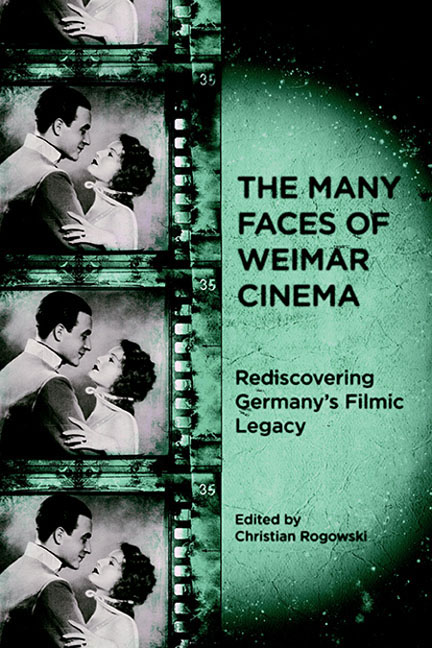Book contents
- Frontmatter
- Contents
- List of Illustrations
- Preface
- Introduction: Images and Imaginaries
- 1 Richard Oswald and the Social Hygiene Film: Promoting Public Health or Promiscuity?
- 2 Unsettling Nerves: Investigating War Trauma in Robert Reinert's Nerven (1919)
- 3 Humanity Unleashed: Anti-Bolshevism as Popular Culture in Early Weimar Cinema
- 4 Desire versus Despotism: The Politics of Sumurun (1920), Ernst Lubitsch's “Oriental” Fantasy
- 5 Romeo with Sidelocks: Jewish-Gentile Romance in E. A. Dupont's Das alte Gesetz (1923) and Other Early Weimar Assimilation Films
- 6 “These Hands Are Not My Hands”: War Trauma and Masculinity in Crisis in Robert Wiene's Orlacs Hände (1924)
- 7 The Star System in Weimar Cinema
- 8 Schaulust: Sexuality and Trauma in Conrad Veidt's Masculine Masquerades
- 9 The Musical Promise of Abstract Film
- 10 The International Project of National(ist) Film: Franz Osten in India
- 11 The Body in Time: Wilhelm Prager's Wege zu Kraft und Schönheit (1925)
- 12 Henrik Galeen's Alraune (1927): The Vamp and The Root of Horror
- 13 The Dialectic of (Sexual) Enlightenment: Wilhelm Dieterle's Geschlecht in Fesseln (1928)
- 14 Babel's Business — On Ufa's Multiple Language Film Versions, 1929–1933
- 15 “A New Era of Peace and Understanding”: The Integration of Sound Film into German Popular Cinema, 1929–1932
- 16 Landscapes of Death: Space and the Mobilization Genre in G. W. Pabst's Westfront 1918 (1930)
- 17 Undermining Babel: Victor Trivas's Niemandsland (1931)
- 18 Unmasking Brigitte Helm and Marlene Dietrich: The Vamp in German Romantic Comedies (1930–33)
- Filmography
- Notes on the Contributors
- Index
17 - Undermining Babel: Victor Trivas's Niemandsland (1931)
Published online by Cambridge University Press: 29 April 2017
- Frontmatter
- Contents
- List of Illustrations
- Preface
- Introduction: Images and Imaginaries
- 1 Richard Oswald and the Social Hygiene Film: Promoting Public Health or Promiscuity?
- 2 Unsettling Nerves: Investigating War Trauma in Robert Reinert's Nerven (1919)
- 3 Humanity Unleashed: Anti-Bolshevism as Popular Culture in Early Weimar Cinema
- 4 Desire versus Despotism: The Politics of Sumurun (1920), Ernst Lubitsch's “Oriental” Fantasy
- 5 Romeo with Sidelocks: Jewish-Gentile Romance in E. A. Dupont's Das alte Gesetz (1923) and Other Early Weimar Assimilation Films
- 6 “These Hands Are Not My Hands”: War Trauma and Masculinity in Crisis in Robert Wiene's Orlacs Hände (1924)
- 7 The Star System in Weimar Cinema
- 8 Schaulust: Sexuality and Trauma in Conrad Veidt's Masculine Masquerades
- 9 The Musical Promise of Abstract Film
- 10 The International Project of National(ist) Film: Franz Osten in India
- 11 The Body in Time: Wilhelm Prager's Wege zu Kraft und Schönheit (1925)
- 12 Henrik Galeen's Alraune (1927): The Vamp and The Root of Horror
- 13 The Dialectic of (Sexual) Enlightenment: Wilhelm Dieterle's Geschlecht in Fesseln (1928)
- 14 Babel's Business — On Ufa's Multiple Language Film Versions, 1929–1933
- 15 “A New Era of Peace and Understanding”: The Integration of Sound Film into German Popular Cinema, 1929–1932
- 16 Landscapes of Death: Space and the Mobilization Genre in G. W. Pabst's Westfront 1918 (1930)
- 17 Undermining Babel: Victor Trivas's Niemandsland (1931)
- 18 Unmasking Brigitte Helm and Marlene Dietrich: The Vamp in German Romantic Comedies (1930–33)
- Filmography
- Notes on the Contributors
- Index
Summary
Christmas 1914. Only a few months after the outbreak of hostilities in the First World War, soldiers in British, French, and German uniforms spontaneously declared a ceasefire and met in the barren strip of earth between the frontlines and trenches, neither possessed nor inhabited by either side, known as no-man's-land. Instead of launching individual guerrilla attacks against each other, for three days the soldiers buried their dead, exchanged gifts, and celebrated the holiday together (Brown/Seaton; Jürgs; Weintraub). In contrast to the familiar image of no-man's-land as a space of carnage, the story of the Christmas Truce transforms this horrifying in-between space into a haven of humanity.
One wonders whether this tale of community and cooperation in the extra-territorial space called no-man's-land inspired Victor Trivas and Leonhard Frank's pacifist 1931 film, Niemandsland, which depicts the chance meeting of five men of different nationalities and armies in an underground ruin between the fronts. In contrast to the depictions of militarism that dominate the film's first half, the relative stability of this subterranean no-man's-land in the middle of the battleground makes it a space of sanctuary. The war among the nations continues here on the level of language, as English, French, and German contend with each other to be understood. It is only through the intervention of one of their number, the African colonial soldier, that the men come to recognize and embrace their similarities and to declare “war on war.” Much as it did during the Christmas Truce 1914, no-man's-land acquires a symbolic meaning in the film as a site of humanity and international cooperation. In the film's dramatic conclusion the five men climb from the grave-like ruin. Side-by-side they march toward the camera, looming ever larger until they fill the frame. From a trench-inspired low angle, the camera records rifles and hands tearing down the barbed wire that encloses them, obstructing their path to freedom.
At its premiere on 10 December 1931 in Berlin's Mozartsaal on Nollendorfplatz, the conclusion of Niemandsland was greeted by thunderous applause. Although it received only a limited release, the mainstream press lauded the film for its humanistic message. Two years later, following the film's US premiere (under the title Hell on Earth), one critic even suggested that “the judges who award the Nobel prize for peace could do worse than consider the parents of this film for their next award” (Trask).
- Type
- Chapter
- Information
- The Many Faces of Weimar CinemaRediscovering Germany's Filmic Legacy, pp. 286 - 298Publisher: Boydell & BrewerPrint publication year: 2010



